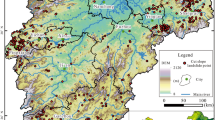Abstract
Zigong City, Sichuan Province, is a typical hilly area, and relatively rough land leveling was carried out in the pre-development of its aviation industrial park, which has caused some damage to the ecological environment. In this study, the Delphi method was used to determine the degree of influence of four ecological factors, namely elevation, slope, woodland and surface water, on the site. Based on the comprehensive scoring of various indexes and the superposition analysis of elements such as current buildings and water systems, the analysis of ecological sensitivity and site suitability was obtained, and a more optimal development and construction plan was proposed accordingly. Based on the GIS model, the area with ecological sensitivity index below 4 is identified as about 167.4 hectares, the valley area along the water system has the highest sensitivity and should be avoided for development and construction, and the mildly sensitive area should be developed and constructed with the principle of minimum interference. The unsuitable construction area is about 65.7 hectares, except for the river mostly for the area where the slope of the site is more than 25 %. Combining the topographic features to determine the low-impact road selection and building layout, different design strategies are proposed for hilltops, ridges, valleys and saddles, and the elevation difference of the site is solved by using staircases to carry out the building layout of a high building on high ground and low building on low ground. This study is a development strategy proposed for the ecological damage caused during the construction of the new area in Zigong City, which has been approved and put into practice by the local government to obtain a better overall urban environment and can provide a reference for other urban developments in hilly areas.
















Similar content being viewed by others
References
China Architecture & Building Press (1994) Architectural design information set, vol 6, Beijing, China, pp 221–236
De Jong M, Joss S, Schraven D, Zhan C, Weijnen M (2015) Sustainable–smart–resilient–low carbon–eco–knowledge cities; making sense of a multitude of concepts promoting sustainable urbanization. J Clean Prod 109:25–38. https://doi.org/10.1016/j.jclepro.2015.02.004
He Z (2012) Research on the application framework of GIS in eco-city design. Dissertation, Harbin Institute of Technology
Hong C, Xu XZ (2013) Application and research on GIS in the design of mountainous cities. Proceedings of the 2nd Expert Forum on Sustainable Development of Mountainous Cities and Towns
Hu SR, Xu H, Gao S (2014) Application of GIS technology in small and medium-sized city design [C]. Urban-Rural Governance and Planning Reform: Proceedings of Annual National Planning Conference 2014
Huang G (2017) Modeling urban spatial growth in mountainous regions of western China. Mt Res Dev 37(3):367–376. https://doi.org/10.1659/mrd-journal-d-16-00078.1
Luo H (2017) Linear landscape study of hilly city in response to topographic features. Dissertation, Xi’an University of Architecture and Technology
Ministry of Housing and Urban-Rural Development of the PRC (2016) CJJ83-2016 Code for vertical planning on urban and rural development land. China Architecture & Building Press, Beijing
Ministry of Transport of the PRC (2015) JTGB01-2014 Technical standard of highway engineering. China Communications Press, Beijing
Nan X (2009) Suitability Assessment of Urban Construction Land in Mountainous Areas with GIS Support. Dissertation, Northwestern University
Ni P, Qiongjie Z (2014) Urban competitiveness and innovation. Books. https://doi.org/10.4337/9781781007921:1-6
Tang Y, Guo L (2015) A Study on Morphological Design Strategies for Hill Cities Based on Slope Analysis. J Mod Urban Res (06):85–92. https://doi.org/10.3969/j.issn.1009-6000.2015.06.014
Tang ZJ, Ye XD, Xia HJ (2012) A preliminary analysis on the protection and utilization of mountains in urban planning: A case study from Fengxi, Zhuzhou City [C]. Proceedings of the Diversity and Inclusion: Annual National Planning Conference 2012 (09). Urban Ecological Planning
Viitanen J, Kingston R (2014) Smart cities and green growth: outsourcing democratic and environmental resilience to the global technology sector.Environment and Planning A 46(4):803–819. https://doi.org/10.1068/a46242
Wang Y (2016) Research on GIS digital terrain analysis methods in mountain city design. Paper presented at the 2016 China Urban Planning Annual Conference, Shenyang, Liaoning, China
Wei S, Wang L (2020) Examining transportation network structures through mobile signaling data in urban China: a case study of Yixing. J Spat Sci. https://doi.org/10.1080/14498596.2020.1791271
Wu Y, Swain RE, Jiang N, Qiao M, Wang H, Bai J, Wu JZ (2020) Design with nature and eco-city design. Ecosyst Health Sustain 6(1). https://doi.org/10.1080/20964129.2020.1781549
Xin J (2012) An ecological approach to urban design in mountainous areas. Dissertation, Chongqing University
Yang X, Wang J, Sun X, Zhang H, Li N, Liu J (2018) Tourism industry-driven changes in land use and ecological risk assessment at Jiuzhaigou UNESCO World Heritage Site. J Spat Sci 63(2):341–358. https://doi.org/10.1080/14498596.2018.1485121
Yang YF (2016) Designing for the city: twelve perspectives and related practices of urban design. Beijing, China, pp 117–133
Acknowledgements
Financial support for the project from State Key Laboratory of Geohazard Prevention and Geoenvironment Protection Independent Research Project (SKLGP2017Z005) and the China Geological Survey (NO.DD20160018-04) are acknowledged.
Author information
Authors and Affiliations
Corresponding authors
Ethics declarations
Conflict of interest
The authors do not have any potential conflict of interest.
Additional information
Communicated by: H. Babaie.
Publisher’s note
Springer Nature remains neutral with regard to jurisdictional claims in published maps and institutional affiliations.
Rights and permissions
About this article
Cite this article
Lin, K., He, Z., Zhao, Z. et al. An eco‐city design methodology for hilly areas of western China. Earth Sci Inform 14, 1609–1623 (2021). https://doi.org/10.1007/s12145-021-00595-5
Received:
Revised:
Accepted:
Published:
Issue Date:
DOI: https://doi.org/10.1007/s12145-021-00595-5




